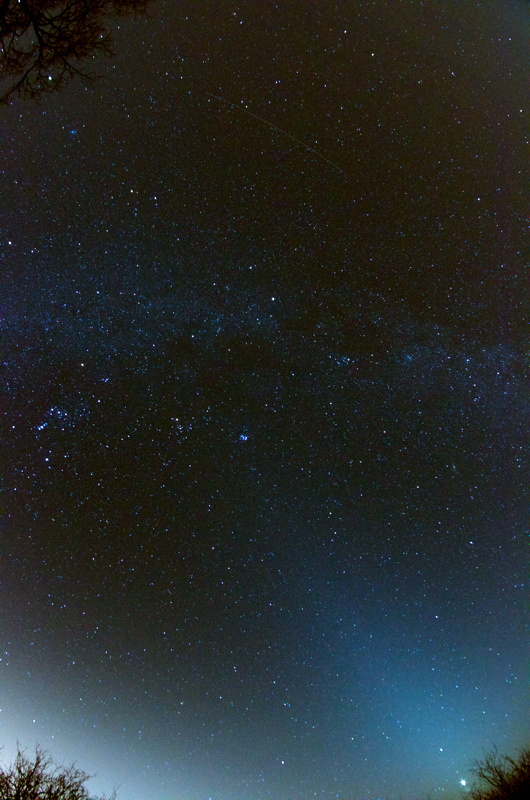Imaging: Zodiacal Light, Jupiter Io Transit
Posted: 9 February 2015
|
Open: Sunday, 8 February 2015, 1755 MST Temperature: 82°F |
Session: 779 Conditions: Clear |
1803 MST: quick look at Venus, 83X. 1804 MST: sunset. Then began setting up for all-sky photography with the D7000 DSLR and 8mm fisheye lens:

1821 MST: viewed Mars, 83X; no details visible. 1830 MST: began viewing Jupiter, low in the east, 83X. Would spend most of the night watching Io and its shadow transit the planet. Added the 2X PowerMate for 166X. The four Galilean Moons were all visible at this point, but seeing was not good due to the planet's low altitude in the sky.
1900 MST: upper portion of the Zodiacal Light was now faintly visible about 25 minutes before the end of Astronomical Twilight. 1915 MST: Zodiacal Light was now nicely visible. Initially I set up the camera aimed towards the zenith with the western sky in the lower righthand corner of the field-of-view. This f/5, 30 seconds, ISO 5000, photograph was taken at 1933 MST:

Mouseover or tap on image for labels
As you can see from the photo above, the Zodiacal Light extended almost to the Pleiades, which was near the zenith.
I moved the camera to aim towards the west and show the observatory. This photo was taken at 1946 MST, f/5, 60 seconds, ISO 2500, and shows the Zodiacal Light on the left and the Milky Way on the right:

Mouseover or tap on image for labels
1952 MST: ended sky imaging. 1954 MST: viewed Jupiter, 166X. Io and its shadow just started their transits. The Great Red Spot was also visible. Began setting up for D7000 DSLR prime focus + 2X PowerMate imaging of Jupiter.
This is a stack of 540 HD video frames using Keith's Image Stacker, 1/200sec, ISO 1600, taken at 2000 MST. The shadow of Io is visible at the right limb of Jupiter, with the Great Red Spot near the central meridian.

At 2006 MST I took this handheld iPhone 5s photo of the D7000 DSLR "live view" screen showing the shadow and the Great Red Spot:

While the transit was progressing I used NightCap Pro for this iPhone 5s photograph of Orion and the star Sirius. The iPhone was mounted on my GorillaPod.

This stack of 604 HD frames, taken at 2029 MST, 1/200sec, ISO 1600, clearly shows the shadow of Io and the Great Red Spot:

2034 MST: removed the camera from the 8" LX200-ACF and resumed Jupiter observing, 166X. Seeing was not great but during moments of good seeing the shadow and Great Red Spot were very sharp. 2044 MST: switched to 222X and continued observing the transit. At 2101 MST took this handheld iPhone 5s photo, afocal 222X, showing that the planet had rotated and the shadow had moved further along:

2132 MST: the Great Red Spot was now rotating towards the planet's limb, making it difficult to see. 2143 MST: the moon Io was now visible as a star-like bright object close to its shadow. I continued observing Io until its transit ended. 2206 MST: ended Jupiter observing.
The eastern sky was now beginning to brighten due to the rising waning gibbous moon.
|
Close: Sunday, 8 February 2015, 2216 MST Temperature: 59°F |
|
Comments are welcome using Email. If you are on Twitter you can use the button below to tweet this report to your followers. Thanks.
Cassiopeia Observatory Home Page
Copyright ©2015 Michael L. Weasner / mweasner@me.com
URL = http://www.weasner.com/co/Reports/2015/02/09/index.html
